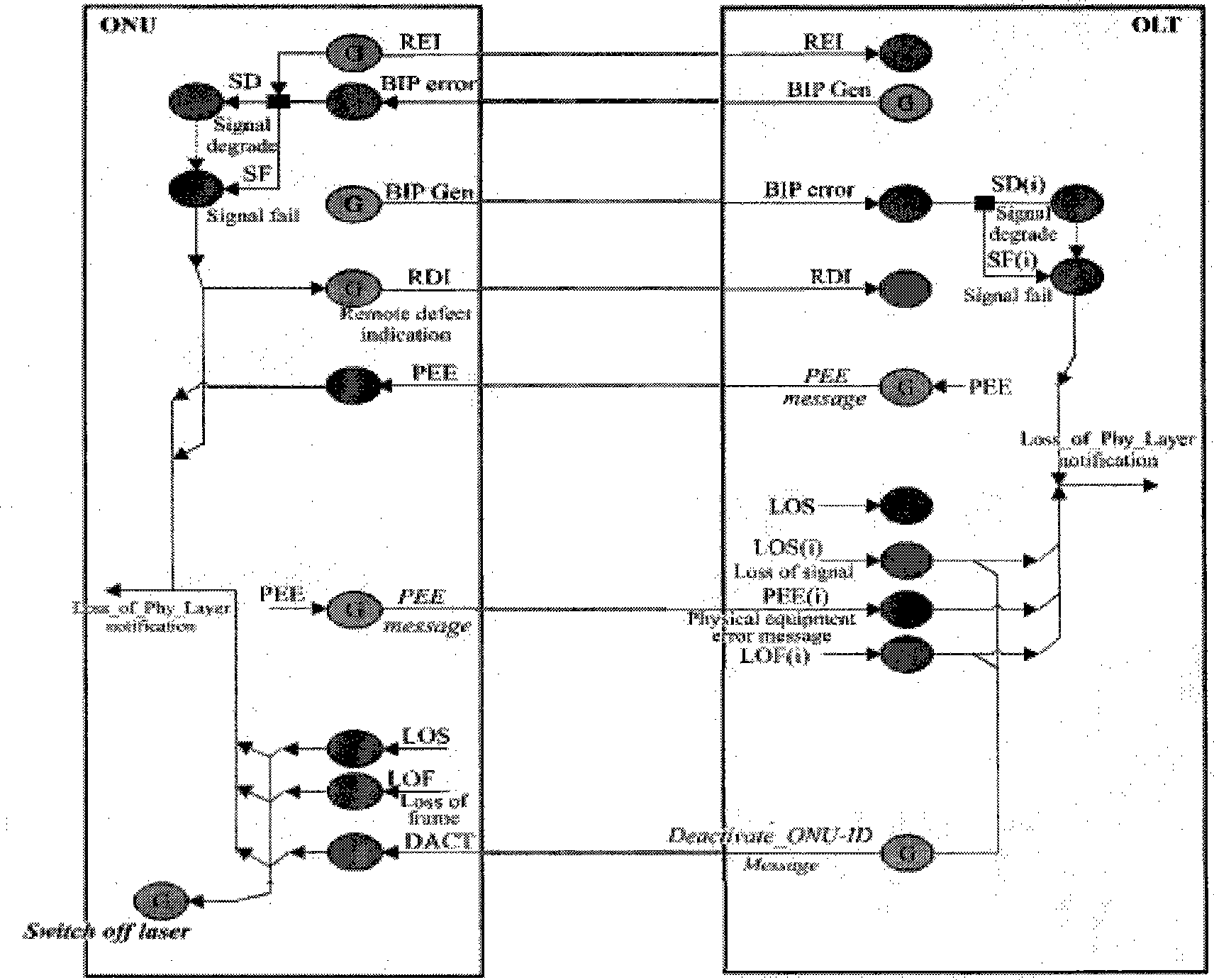Method, system and apparatus managing alarm of long-distance passive optical network system
A passive optical network and alarm management technology, which is applied in the field of alarm management in long-distance PON systems, can solve the problem of inability to analyze and locate intermediate nodes, not providing long-distance PON signal transmission quality, and not providing LR-PON signal monitoring and alarm indication Problems such as handling methods to achieve the effect of convenient maintenance of equipment
- Summary
- Abstract
- Description
- Claims
- Application Information
AI Technical Summary
Problems solved by technology
Method used
Image
Examples
Embodiment 1
[0052] see Figure 4 , Figure 4 It is a schematic diagram of an alarm link according to an embodiment of the present invention. In this embodiment, only some alarm detection functions are added to the electrical relay regenerator, and no changes are made to the ONU and the OLT.
[0053] Down direction:
[0054] After the electrical relay regenerator detects the LOS and LOF alarms, it turns off the transmitting laser in the downlink direction, which causes the ONU to detect the LOS alarm in the downlink direction. There is a failure in the downstream path to the ONU that causes signal loss. When the electrical relay regenerator receives and clears the LOS and LOF alarms, it restarts the transmitting laser in the downlink direction.
[0055] Up direction:
[0056] After the electrical relay regenerator detects the LOS alarm, it turns off the transmitting laser in the uplink direction, which causes the OLT to detect the LOS alarm in the uplink direction, and the subsequent ...
Embodiment 2
[0061] see Figure 5 , Figure 5 It is a schematic diagram of an alarm link in Embodiment 2 of the present invention. In this embodiment, compared with Embodiment 1, an alarm return function is added to the electrical relay regenerator; three types of alarm detection and processing are added to the OLT to facilitate fault judgment and location; no changes are made to the ONU.
[0062] Down direction:
[0063] After the electrical relay regenerator detects the LOS and LOF alarms, it turns off the transmitting laser in the downlink direction. The details are the same as those described in Embodiment 1 and will not be repeated here.
[0064] After the electrical relay regenerator detects the LOS and LOF alarms, it returns the correspondingly set third type of downlink alarm indication signal to the OLT, where the third type of downlink alarm indication signal is RDIu;
[0065] After receiving the RDIu alarm, as shown in Table 1 above, the OLT determines that the downlink path ...
Embodiment 3
[0077] see Figure 7 , Figure 7 It is a schematic diagram of an alarm link in Embodiment 3 of the present invention. In this embodiment, compared with the second embodiment, an alarm return function is added to the electrical relay regenerator; two new alarm detection and processing are added to the ONU.
[0078] Down direction:
[0079] After the electrical relay regenerator detects the LOS and LOF alarms, it no longer turns off the transmitting laser in the downlink direction, but inserts the first type of downlink alarm indication signal to the ONU, and the first type of downlink alarm indication signal is AISd.
[0080] After receiving the AISd alarm, the ONU determines that the downlink path from the OLT to the electrical repeater regenerator has a fault that causes signal loss or frame loss; as shown in Table 3 above, the ONU suppresses the LOF alarm.
[0081] In the above steps, the down-insertion AISd alarm is a kind of "alarm frame", and its frame header can refer...
PUM
 Login to View More
Login to View More Abstract
Description
Claims
Application Information
 Login to View More
Login to View More - R&D
- Intellectual Property
- Life Sciences
- Materials
- Tech Scout
- Unparalleled Data Quality
- Higher Quality Content
- 60% Fewer Hallucinations
Browse by: Latest US Patents, China's latest patents, Technical Efficacy Thesaurus, Application Domain, Technology Topic, Popular Technical Reports.
© 2025 PatSnap. All rights reserved.Legal|Privacy policy|Modern Slavery Act Transparency Statement|Sitemap|About US| Contact US: help@patsnap.com



